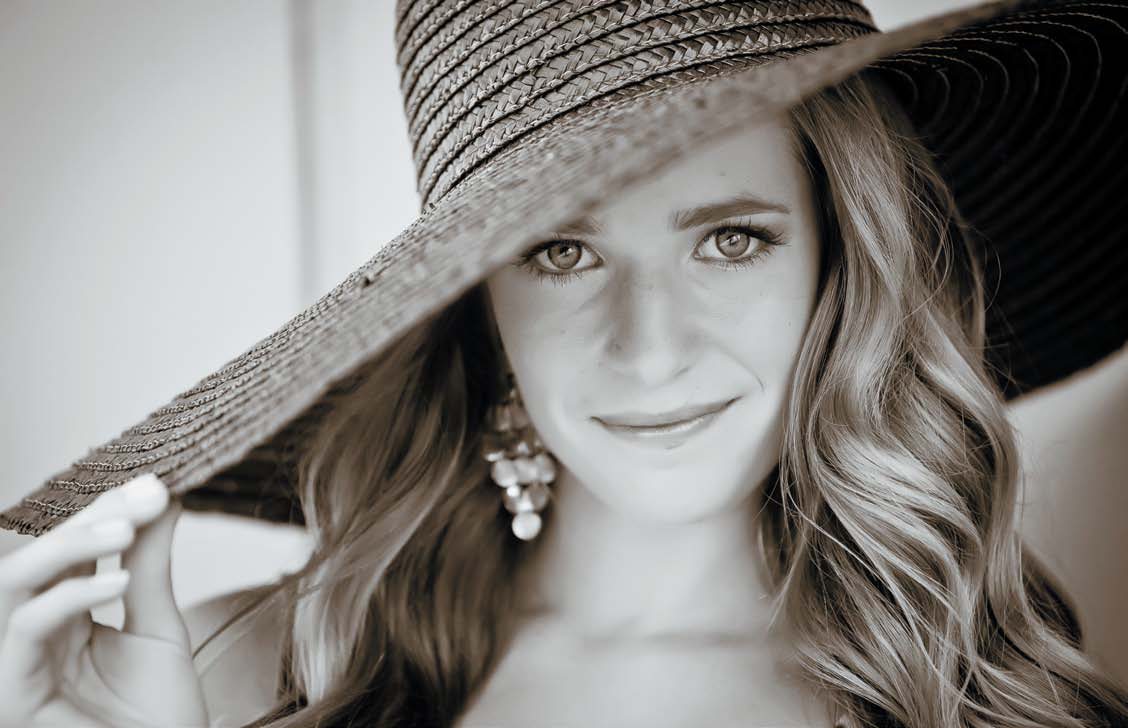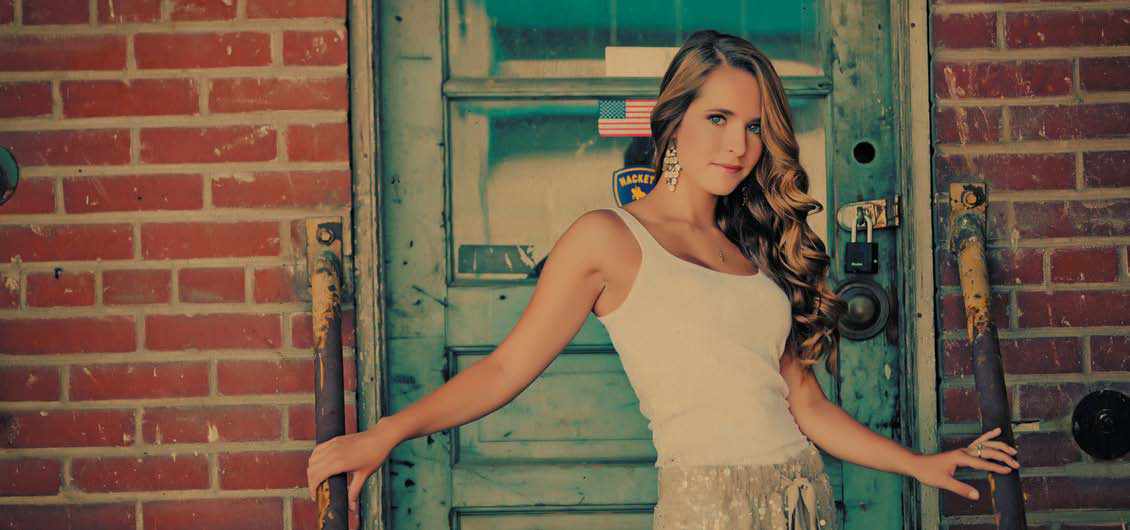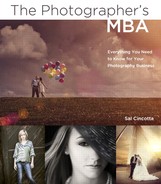One. So You Want to Be a Photographer

In this chapter we’ll explore the photography industry and the influences that are shaping it today. The industry has gone through immense changes, and unless you truly understand the past, you’ll be destined to repeat its mistakes. A career in photography can be extremely exciting, but it’s not without its challenges. Once you understand the pros and cons of a career in professional photography, you’ll be better equipped to make informed decisions.
While there is little to no barrier to becoming a “professional” if you want to make photography a career versus a hobby, it’s best to learn as much as you can before you take the leap. I’ve been at this since I was 17, and I still learn something new every day. It truly is a journey and not a destination.
A Career as a Professional Photographer
Being a professional photographer can be a rewarding experience. Every day I wake up and realize I’m the luckiest person alive. I get to follow my dreams and passions, all while making a very decent living.
My job is to document life’s moments for my clients. I’m in the business of making people happy. My clients love seeing images of themselves during some of the most memorable moments in their lives. Weddings, newborns, high school seniors, and family portraits: all are happy moments in our lives and we get to document them and be the “hero,” if you will.
Sure, it’s not without its risks or pitfalls, but at the end of the day, would you rather work for someone else doing the same mundane tasks day in and day out, making money for some corporate giant, or would you like to take some risk and enjoy the rewards of your labor? It’s not an easy decision to make. As individuals, we’re all motivated by different things—some of us are driven by money and the prospect of independence, whereas others want more job security and work-life balance.
Photography offers many opportunities for additional income. In recent years, there has been a huge influx of new photographers into our industry who I refer to as “weekend warriors.” Because there’s little to no barrier to entry, photography has offered many of us an alternative revenue stream. Be careful, though. Being a photographer comes with great responsibilities. If you’re working with people, they have typically entrusted you with their most important memories. Don’t take that responsibility lightly.
So let’s explore the pros and cons of a career in photography. I’m going to start with the potential negative aspects. I’m not a doom-and-gloomer by any stretch of the imagination, but unfortunately, I meet with a lot of people who seem to think being a photographer is all glamour, and I’m here to tell you about the realities of being in business for yourself. I find that if you know what you’re getting into ahead of time, you’re rarely surprised. To be a successful businessperson, you have to operate based on worst-case scenarios. Then, you’ll never be surprised if—and when—something goes wrong.
The Cons
It’s not an exhaustive list, but these are some of the things I see as potential negative aspects to my job based on my experiences as a wedding and portrait photographer.
The Inherent Risk of Being an Entrepreneur
Make no mistake: if you decide to embark on a career as a professional photographer, you are in fact a businessperson and an entrepreneur by definition. I know a lot of artists who struggle with wrapping their heads around this fact, but though you may be an artist, you are and must be a businessperson first.
As an entrepreneur, you’re shouldering all the risks that go along with any business venture. What do you do if someone trips over your bag and hurts themselves? What happens if your gear is lost, stolen, or damaged? These are serious questions you must ask yourself and have a contingency plan for. Without a contingency plan, you run the risk of letting down your clients and might face potential legal action that could impact your business and personal life. So, these are things you have to be thinking about. Throughout this book, we’ll discuss various business models and strategies for addressing some of these questions, but we have to start thinking about this now as it shapes our thought process for creating our business plan moving forward.
In addition, you always run the risk of failing. Every successful entrepreneur will tell you they have failed more than they have found success. Failing is and can be a good thing for any business. Don’t personalize it, and most importantly, don’t let the prospect of failure cripple you from taking the leap to being a professional. Just know and understand that failure is always lurking in the shadows.
For me, I’m a student of the successes and failures of major corporations around the world. I’m a huge believer in learning from the mistakes of others. It always fascinates me to see how a corporation filled with brilliant minds can still make the same stupid mistakes we do as small business owners. From products or services that don’t resonate with clients to poor branding, the challenges and solutions are the same for small businesses as they are for large corporations. And at the end of the day, it all comes down to execution.
Center of Operations
Where will you operate from? This should be a burning question in your mind before you embark on this journey. Can you imagine starting a florist business and selling them at your local coffee shop? Sounds ridiculous, doesn’t it? However, the new generation of photographer seems to be okay without having a center of operation for their business. You have to be concerned with this; ultimately, clients will make decisions on the validity of your business based on such things.

Put yourself in your client’s shoes for a second and ask yourself this: Would you buy a TV from someone selling them in a back alley somewhere? No? Really? Why? I know why—because you would immediately think, “This can’t be legit. I mean, he wants $2,000 for a TV I can’t turn on, test, anything? What do I do if I have to return this? Will he be here in the alley for me six months from now if something were to go wrong? Probably not.” That would be the normal way to think about this, and you’d be correct in being cautious and concerned. (Actually, I’d seriously be worried about you if you were to consider buying that TV. I’m just sayin’.)
You’ll find that my barometer for decision making in my business is usually tied to how I would behave as a consumer. If it doesn’t pass my personal sniff test, there’s no way I’m pushing this out to clients.
Let’s come back to my point here. If you’d have caution as a consumer, think about what that bride might be thinking or feeling when you’re asking her to invest a couple of thousand dollars into your business—and more significantly, trust you with the most important day of her life.
We’ll talk more about a home-based business versus retail space later, but you need to start thinking about this issue now and know it can be a potentially negative and limiting aspect to starting a new business.
Competition
If you’re in business, you have competitors. That’s a fact! And in this particular industry, everyone is a photographer. With no barrier to entry, you can go to your local big box store, pick up one of those nifty new cameras with its kit lens, and you’re in business and ready to go. No need to understand lighting, how to use your camera, digital workflow, business skills, and so forth.
I’m not advocating this approach—I’m merely highlighting the reality of today’s landscape. This is the world we live in. My studio is faced with competition from everywhere. Parents who had a child and picked up a camera to document their child’s life are now photographers. Studios are popping up all over the place, charging 25 percent of my rates. Worse yet, they are shooting and burning.
In order for us to compete, we don’t lower our price or put out an inferior product. I never want my studio to be known as the low-cost provider. Instead, we raise our prices and offer a superior product or service. That’s business.
In my opinion, today’s consumer is okay with “good enough” when it comes to photography. They’re seeing images from almost every kind of device, from iPhones and iPads to point-and-shoot cameras. They’re becoming numb to tried-and-true postproduction editing techniques, and it takes more and more to impress a client. That’s where other studios and photographers are failing. Instead of innovating, they’re settling for “good enough.” So consider where you want to position your business and how you plan on getting there. We’ll explore your business plan in later chapters.
Work-Life Balance
Being in business means you get to call all the shots, no pun intended. However, it also means you get to call all the shots. I can honestly say that I work more hours now than I ever did in corporate America. Yes, I’m here to burst your bubble right now; you can erase those glamorous thoughts of work-life balance, dancing in the park with your spouse with all your free time, and, of course, sleeping in.
Unfortunately, that doesn’t exist. Sorry. As a small business owner, you’re responsible for every facet of your business. There’s no one to cover for you while you are on vacation. Clients are calling expecting customer service, appointments need to be scheduled, accounting books need to be kept, taxes need to be paid, and somewhere in there I’m supposed to take pictures? After all, this is how I make my money. If I don’t shoot, I don’t get paid.
Of course, there are ways to outsource and find partners and employees to help as you grow, but when you first get started there’s a lot of work to do if you’re going to run a successful business. And most importantly, this is work you want to be heavily involved in.
When I started out in my business, I was part of everything going on. Sure, I’m a control freak, but when your name is on everything and your reputation is on the line, you better be a bit of a control freak.
Expenses
Startup expenses can be costly, especially in the beginning. I’ll never forget my first 60 days in business, where I went through $14,000 like it was play money. And the panic set in. How would I continue to grow? Would the expenses ever end? It was a tough time for me and my family, both personally and financially. I want you to have a realistic appreciation for what your potential expenses could be. They add up quickly.
All too often, photographers are under the impression that all they need is a camera, a lens, and a flash. Trust me when I tell you that you need a lot more than that when you’re starting out. Do it right or don’t do it at all! That is a mantra you’ll hear from me over and over again.
Things to consider right out of the gate:
• Training
• Cameras, lenses, memory cards, flash, battery packs, reflectors, etc.
• Computer (to edit images)
• Hard drives
• Software like Adobe Photoshop, Lightroom, and plug-ins
• Insurance
• Incorporation expenses
• New website
• New logo
• Rent for studio space
• Advertising and marketing expenses to let people know your business exists
And the list goes on and on. Some of these we’ll explore in greater detail in other chapters. The main point here is to understand that there can be a lot of hidden costs to starting your own business and to understand that there’s a lot more that goes into running your business than merely picking up a new camera.
Legal/Professional Services
If you’re serious about starting a business, then you had better get legal. A lot of photographers just grab their camera and continue happily along until something bad happens, and they find themselves—and all their personal assets—exposed to a potential lawsuit.
Incorporating your business is something that you need to do in order to protect and insulate your personal assets from your professional assets. As I mentioned earlier, what happens when you are at an event and someone trips over your bag and seriously hurts themselves? Or you lose a memory card from a wedding event? You’d be naïve to think these things can’t happen to you, right? You have to protect your business, and all things considered, it’s less expensive to form a legal entity than it is to deal with the fallout if something bad were to happen to your business. The cost of incorporation is about $1000–$1500 in most states. We’ll explore the options in Chapter 2, “Let’s Talk Business.”
In addition, you have to think about your books—you know, those pesky little business tasks like balancing your checkbook, paying taxes, and so forth. When I started out, I thought I could handle all this on my own. I mean, after all, I was a business school graduate and a successful and accomplished corporate leader; surely I could handle tracking my expenses and income. Wow, was I wrong! A year and a half later, I was so far behind it took my accounting team six months to get my books right and all my taxes up to date. The last thing any business wants to spend money on is paying penalties for being late on taxes. This is a serious task and you need professional help ensuring that you’re set up correctly, expensing the right things, and paying your taxes on time. Get a referral and meet with an accountant; you’ll be surprised by how much they can help you plan in a simple one-hour consultation.
Technology
Ah yes, my favorite: technology. The one thing I learned when I worked at Microsoft is that the only constant today is change. Every day, there’s a new social media format, new gadget, lens adapter, light modifier, and Lightroom plug-in, and they’re all claiming to be revolutionary. Every day, my competitors are trying to leapfrog my business and steal market share by being more innovative than my studio.
Today, you have to innovate or die. I know that sounds horrible, but it’s the truth. I see studios all over the country struggling to survive because they’ve refused to adapt to the new way of doing business. I feel like we’re going through the second major revolution of our industry—at least in my lifetime.
First was the introduction of digital. It changed everything! Photographers around the world refused to adopt the new technology and the new workflows that were part of this digital revolution. And today, most, if not all of them, are extinct. Sure, a handful of photographers still shoot film, but they are few and far between. Just ask the film companies. Oh wait, you can’t. They didn’t adapt either.
Now, the new revolution is the influx of new shooters into our market. Taking a decent picture has been made so simple by the camera manufacturers that everyone and their mother is now a photographer. The challenge? Competing in a saturated market. In the past, photography was ruled by the geeks. It was a somewhat technical landscape. F-stops, shutter speeds, lighting ratios—what in the world did it all mean? You needed someone who could make sense out of all the technical mumbo-jumbo before they could click the shutter.
Not anymore. Today, slap that bad boy in P for Pro and you’re well on your way. The landscape is being ruled by young, trendy, cool hipsters who are more approachable and Internet savvy. And the technically sound photographer is left trying to figure out what a blog is.
I spoke at a conference recently, and I was dumbfounded by the number of people who still hadn’t set up a page on Facebook for their business. I got the same question again and again from the established studio: do you really think I need a Facebook page? Um, yeah, like two years ago you needed it. Tomorrow, I’m sure there will be another Facebook-like concept we have to contend with and we must be ready to adapt or we’ll quickly become irrelevant.
Client Expectations
Sure, customer service is a keystone to my business—and all our businesses for that matter. However, meeting client expectations can be a challenge for the best businesses in the world. I find that sometimes there are clients that you just can’t make happy. No matter what you do, they seem to be looking for what you’re doing wrong versus what you did right. I refer to this group as the 2 percenters. Sounds like a gang, doesn’t it? Sometimes I wonder if they’re all secretly conspiring against the businesses and entrepreneurs of the world, and then I realize they’d probably have a Facebook page for that.
You might be wondering why I see this as a negative thing. Well, for me, I want to take pictures and enjoy the positive and happy side of why I chose to become a photographer. Dealing with client issues isn’t something I look forward to every day. And any photographer who tells you they don’t have client issues is full of it. We all do. It’s how you deal with them that defines your business.
One hundred percent customer satisfaction is nearly impossible to achieve. For example, I once had a bride have a near meltdown because I missed shots at her wedding. When the call came in, I was horrified and immediately started apologizing. I said, “I’m so sorry, what did I miss? I thought I was pretty in tune with the day and everything going on. I was with you for nearly everything.” Her response immediately changed my demeanor and response. “Well, we had artichokes on the table as décor and you didn’t take a picture of them.” There was a slight pause on my end as I waited for someone to tell me there was a hidden camera in my house and this was a joke. No such luck. I responded, shocked and annoyed. I said, “I’m sorry I missed the artichoke, but you have a million table shots, was there a reason you needed a single shot of the artichoke? Are you planning on printing this?” She answered no. I then asked if she was planning on putting it in her wedding album? She answered no. I said, “Well, I guess I’m a little confused. You’re calling me, upset, telling me I missed shots, but you have no plans on printing this or using it in any way, shape, or form. What exactly are we talking about?”
Probably not a good example of good customer service, but the truth is, there are certain clients who are just looking for things to complain about. That’s not a glamorous part of being in business for yourself, because you’ll ultimately have to be the one dealing with it. Among all the other roles you play, you are the customer service rep.
The Pros
Now I hope I didn’t scare you off. My only goal was to open your eyes to some of the negative aspects—challenges, if you will—of being in business for yourself. I love when I talk to new photographers and they are all wide-eyed at the prospect of starting their own business and being a professional, and then they become saddened and disillusioned when things get tough. If you understand the potential challenges and risks before you get started, you’ll be well prepared to deal with such issues when they arise.
Let’s dig into some of the positive aspects to being a professional photographer. This part will be easy for me—it’s what I love about my job.
Creativity
I love being a creative. Every day, I wake up and create. It’s like a giant science experiment. I try something out, and if it works, great. If not, I try again. And the process continues. It’s the main reason I got hooked on photography. I love being able to create an image the way I envision it. I tell everyone to be true to themselves as an artist. The worst thing you can do is try to be everything to everyone.
I shoot the way I see the world. This ensures I find the right clients or, in reality, they find me. I think you can look at one of my images and see a part of me in it. And that’s what it’s all about for me. I’m creating something with a piece of me in it that will last forever.
Are you a creative person? What do you love to shoot? Maybe you don’t know yet. Well, get out there and start experimenting. What’s the worst thing that could happen? Find your niche. Find what you love and then find a way to apply the business principles I’ll teach you to turn it into more than a hobby. Turn it into a career. Turn it into something you can make a living at and support your family with.
Trust me when I tell you that if you do what you love every day, you’ll never work a day in your life. I love what I do, and as exhausting as it can be, I wake up excited to go to work every single day. How many people do you know who love to go to work? Exactly. Well, now you know one. Me.
Working for Yourself
This is something that can go either way. You know the old adage: no risk, no reward. However, for me, this is one of the main pros of being a professional photographer. I get to call the shots. It’s my business, my vision, my success, and of course, my failure. It’s so exhilarating to know that I can create an image, sell it, profit from it, and navigate the future direction for myself. I get to control my own destiny.
This is a totally different mind-set for a lot of people. I run into people all the time who just want to punch a clock 9–5 and have someone tell them what to do. They need that structure to survive. I’m the opposite. My personality is to challenge the status quo...to work outside the box. Oddly enough, it’s that differentiation that has allowed my business to thrive in what has been a down economy. My studio stands out from the crowd.
Are you working for a company that has stifled all creativity? How do you define your own success? I think it’s a challenge. Being out on your own allows you to control your own destiny. And that, in and of itself, is worth it. We all need flexibility in our schedules and job tasks. There’s never a dull moment in our studio. Every day seems to present itself with new and exciting business challenges. One day I’m shooting for 10 hours and the next I’m working on a marketing plan for our next bridal show. I get to have my hands in a little bit of everything.
I’ll never forget when I left my corporate job. My boss thought I was crazy. Hell, I think my entire family thought I was crazy. But I moved forward with one thought in my mind. I’d rather make less money and do what I love than continue to work for someone else doing the same thing every day, being tied to a desk, and meetings, and rush-hour traffic.... I have never looked back. This has been the most amazing journey of my life.
Being in the Business of Happy
Here’s something to think about. You are in the business of happy. What do I mean by that? Well, most people come to our studio to create memories and document moments in their lives. When I show them their imagery, they’re usually silly happy and so grateful for what we’ve given them. They truly see it as a gift.
Okay, so let me get this straight, Sal. You get paid for making people happy? Yes. Yes, I do. It’s the most amazing feeling in the world to create art for someone that they, along with their families, will enjoy forever. How many people can look in the mirror and say they get to do that?
I take that mind-set into every photo shoot. I want to showcase my clients in the best possible light. I want to deliver to them a snapshot of a moment in time when they remember being happy. That’s my gift to them, and that’s my job.
I was recently in New York shooting an engagement couple and a high school senior. These were clients who flew in from St Louis. We had a blast with them driving all over the city, talking, sharing goofy stories, and laughing. When it was all said and done, we captured amazing imagery that not only will they be able to look at for the rest of their lives, but they will have a story to tell about each one of those images and how they were created. Best of all, I’ll always be a part of that memory. How cool is that?
There’s nothing more rewarding than having someone thank you from the bottom of their heart for an experience they’ll never forget. That’s truly the main fuel that keeps me going no matter how exhausted I may be. I want to be part of something bigger than I am and be part of it in a positive way.
The Money
Whoa. Money? You mean we can make money and be happy at the same time? There is nothing glamorous about being a starving artist. I am a businessman first and an artist second. I’m okay with that distinction. In fact, that’s why you’re reading this book. You need to understand that without the business, being an artist can be a somewhat fruitless experience. I know there are going to be some purists out there who disagree with my assessment, but did you read the cons of being in this business? If you did, then you’ll realize that there’s no point in taking all this risk and extra work upon yourself if you aren’t trying to make a profit. That just doesn’t make any sense.
Now, I won’t lie. When I got into this I didn’t get into it for the money. I got into it to do what I loved. However, in order to continue doing what I love, I need money. Money for new equipment, training, and the list of things we’ve already talked about. Not to mention, I want to retire someday. How will you retire if you can barely make ends meet? You need money!
That being said, our business has been more profitable than I could’ve ever imagined. More profitable than any desk job I’d have had if I’d stayed at my corporate job. None of this would have been possible had I not engaged in basic business concepts for my business. Don’t underestimate the importance of being a businessperson first.
The great part about a career in photography is that you can make as much or as little as you want. I mean that with all sincerity. If you told me you wanted to make $250,000 per year, I would tell you that’s 100 percent entirely possible. Tell me that’s not amazing! Now tell me you can walk into your boss’s office at your next review and ask for a $250,000 job. After you pack up your desk you’ll be left trying to figure out what’s next.
Are you getting this? The sky is the limit for you. There’s no end to the possibilities. I’m not saying it will be easy or you’ll get to that point working 20 hours a week with weekends and holidays off. Instead, I’m telling you that you are 100 percent in control of your own destiny. And that, my friends, is priceless.
Defining Your Own Success
The one thing I want you to keep in mind throughout this entire book is that you and only you control your destiny. I’ve mentioned that several times now, but what does that mean? When I’m helping and consulting with new photographers, one of the first questions I ask is, “What does success look like for you?” Sometimes this will catch them off guard. Success doesn’t have to be synonymous with money. Success can come in many shapes and sizes. That’s ultimately up to you to define. And that’s the point.
Ask yourself this: How much do you want to work? How much money are you looking to make per year? And don’t forget those pesky expenses. Do you want to travel? When are you looking to retire?
It’s by answering questions like these that you’ll start to form the foundation of your business plan, which we’ll explore in Chapter 3, “The Business Plan.” The key here is understanding that you are truly in control of your path. And knowing that this path can change at any time. You might wake up one morning and realize you want to go on a trip to Europe for a month. I say, awesome! You have to pay for that, so maybe you take on a few more events and adjust your plan accordingly. Or maybe you’re burned out and want to cut back on events and just chill out by the pool for the summer with your family. Not a problem—just make sure you adjust your plan so that when you decide to pick back up again, you aren’t starting from scratch.
The future is bright, and it’s yours for the taking! Don’t let anyone tell you any differently. Believe in your dreams and believe in yourself.
Now that you have a basic understanding of the risks and rewards of embarking on this new venture, you’re in a better place to make an informed decision. The next logical question might be, “How do I get started?”
Getting Started
First, let me tell you how I got started. I was working in corporate and was burned out working for someone else. No matter how hard I worked or how many hours I put in, it never seemed to be enough. And my pay never seemed to match the effort I was putting in. I wanted something different. I was looking for a new challenge.
I got involved in photography at an early age. I was 17 when I shot my first wedding. I assisted someone, and though I enjoyed it, weddings back in the 1980s were, well, pretty freaking lame. I moved over to shooting landscapes, and before I knew it I had a camera with me at all times on every vacation, taking cool pictures of architecture for our home. All the while I was working my corporate job. Never in a million years did I think I’d become a professional photographer.
Back in corporate, a coworker of mine was renting a studio space and wanted me to share it with him. I thought, what the hell. I did it and was immediately hooked again. I couldn’t get enough. I was reading every book out there on lighting and posing. Oddly enough, there weren’t many books on the business side of photography.

I was building my portfolio shooting anything I could. I photographed pets, families, couples, children, prenatal. This was a great experience for me; it helped me define my style and gain confidence and experience in my craft. One day, my buddy had a wedding booked and asked me to help. I had no idea what I was doing at this stage of my career. I was like, “Sure, count me in.” And it was that day when I found my niche. I literally hijacked the wedding from him. I started directing people, telling them where to go, how to pose, and creating cool scenes in what’s now my signature look. I love incorporating people and architecture into an image. It’s what our studio has become known for. From that day on, I’ve never looked back and there has never been a doubt in my mind that I was going to be a professional photographer.
So, how do you get started? Shoot. Shoot. Shoot. Get out there and just start shooting anything and everything you can. You need to build your portfolio and start defining your style. Who are you as an artist? What are you passionate about? What do you want to shoot? If you are shy and timid, you might have trouble working with large groups. If you have an outgoing personality, working with fruit all day isn’t going to quite make the grade. I might be tempted to eat it and then go outside and start photographing people. The only way to figure this out is to get out there and work with someone—or work with everyone. Reach out to friends and family at first. Tell them you’re building your portfolio and looking to work with them. Offer them free pictures for their time. It’s better than paying a model and it’s a win-win for both of you.
Read the damn manual that came with your camera. I can’t tell you how nuts it makes me every time I host a workshop and photographers have no clue how to change a setting. Look, I know it’s not the most exciting thing in the world to read. But you have to know how to work your tool if you’re going to use it correctly. All these shoots you’re doing with friends and family—that’s your time to experiment and play with different settings on your camera.
As you get more and more comfortable with your camera, consider approaching some local photographers and offering to assist on some photo shoots as a second shooter or even work on their bag. I promise, you’ll learn more working on a photographer’s bag than you’ll ever learn in a book. All the photographers who’ve worked for me started out on my bag. They have to learn to understand light, how to see a shot before ever taking it, what equipment to use in what situation, and most importantly, understand my thought process and how to deal with the unexpected. You’ll gain priceless knowledge.
I think it’s at this point you’re ready to consider going out on your own and moving toward building a business plan. You’ll be armed with some experience and an understanding of what type of photography you’d like to offer. And most essential of all, you’ll have a portfolio of work to show prospective clients.
Final Thoughts
A career in photography can be both rewarding and challenging. Just understand there’s more to it than buying a new camera. A true professional is armed with knowledge about the potential pitfalls their business will face and the knowledge to correctly navigate the competitive landscape that lies ahead.
Although there’s seemingly no barrier to entry, you’d be foolish to jump in without asking yourself basic questions and ensuring you know where you’re heading on this new journey. Remember, do it right or don’t do it at all. Take the time up front to ensure that you’re making the right choices—doing so will save you pain and money in the future.
Next Steps
• Make sure you have a thorough grasp of the pros and cons of being a professional photographer.
• Connect with friends and family and start shooting as much as you can. On every shoot think about learning and building your portfolio. Shoot without fear. Don’t be afraid to experiment.
• Find your niche. What do you want to shoot? Where is your passion?
• Find photographers whose images inspire you. Use them for inspiration in your shooting.
• Find online resources for learning. Learn about lighting techniques, posing techniques, and the various aspects of producing a great image.
• Once you’re ready, try getting an internship or part-time work with a photographer who would be open to training and mentoring you.







